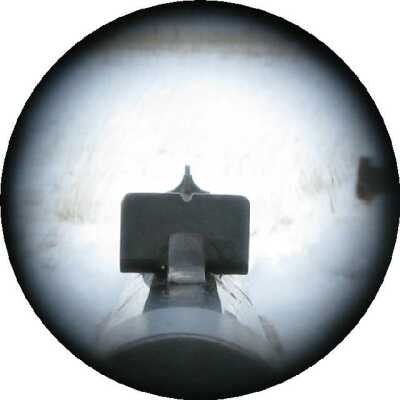 |
| The essence of what your eye sees through a large aperture sight. |
The Envelope Please!
My Best Rifle Sight Award Goes To…
by Ross Seyfried
Let’s start this month with a question. It may not be the best writing form, but let’s go for it.
Is there a way to correct your shooting vision without corrective lenses, without a scope, and with nothing more than a plain iron sight? And no, I’m not going to give you the answer right away.
We can begin by saying that any shot that can be made with any iron sight can be made more easily with a scope. But having said that, there are many times and applications when, for a variety of reasons, a “glass” sight is not what we want. There are kinds of hunts or places where “optical” sights are not legal, many muzzle loader seasons fit in this realm. At times we simply do not want the large “clutter” of a scope on top of our rifle. Optical sights, as good as they are, are by their very nature more fragile than “iron,” so at times for sheer ruggedness or as a backup if the scope fails, iron sights are better. Also, we may not want a scope for nostalgic reasons and last but not least there are many rifles that would be severely “damaged” if a scope were mounted on them. So, at the end of the day many, (including most military applications) turn to iron sights instead of scopes.
| Article continues below… Please support our advertisers!  … click opens in new window. |
The most basic and common kind of sight, those on the barrels of a vast majority of rifles are “open” sights. They come in a wide variety of flavors: buckhorn, square notch, “V” express sights and on and on. They are fine and wonderful things and have served riflemen well as long as there have been rifles. But they have two very distinct drawbacks. First they are very skill oriented. Open sights, regardless of opinion to the contrary, are difficult to master.
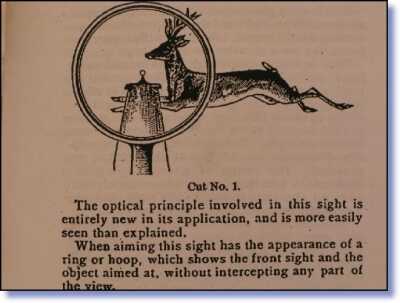 |
| This description is from Lyman’s 1888 catalog, describing the “new” sight and showing what the shooter should see. |
Second, they depend on good eye sight. Regrettably most, mine included, begin to lose open sights somewhere past 40 years of age. Also, many with less than perfect vision including those with corrective lenses have great difficulty hitting well with open sights. If you can not see the the sights on your rifle well, you cannot hit well with them either.
But have no fear! There is a “magical sight.” Yes, there is an iron sight with extreme precision, that is extremely fast and . . . .drum roll . . . one that corrects virtually any vision problem to perfection. And no, it is not some product of the space program, computerized lasers or witch doctors. It is a simple, round, hole!
Now before you damage your computer and toss out all marginal credibility I might have, let me explain the how it works. Better yet, you can test it for yourself. Of course those of you with perfect vision cannot appreciate this one facet of apertures, but hold tight, we will get to the rest of you in a minute. Take a piece of thin card board and poke a small hole in it with a sharp pencil or ball point pen. Then put the hole very close to your eye and look at some very fine print . . . and then out the window at a distant object. Yes, it is indeed almost magic. An eye surgeon friend told me that he can use a pin hole to demonstrate how good a person’s corrected vision can be, without any of the fancy optical tools. There are of course medical problems, cataracts, etc that the aperture cannot help, but the large majority of “fuzziness” both near and far is zapped away with a simple hole. My eyes see sights and read perfectly, until I put on my prescription lenses to correct my distance vision. Then the sights become very blurry. An aperture makes the sights crisp with my glasses and leaves my distance vision perfect as well.
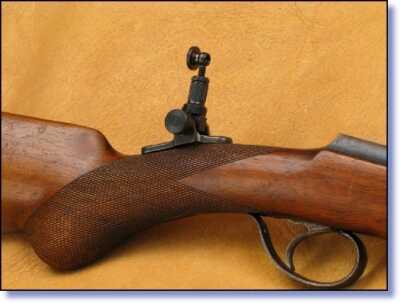 |
| The new Marbles tang sights are adjustable for elevation and windage, and fold down when not in use. |
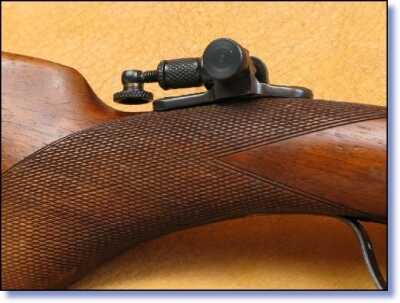 |
The essence of a “peep” or aperture sight is nothing more or less than a round hole that serves as the rear sight on a rifle. The magic of an aperture sight does not end with the almost miraculous ability to allow the shooter to see well. The greatest challenge with normal open sights is a thing called sight alignment. That is, the front and rear sights must be in almost perfect alignment with each other and the target, or the shot goes astray. The eyes must focus well and the mind must concentrate on that all-important alignment, while the trigger finger releases the shot. There is a whole lot going on and much that can go wrong. This is partly why the optical sight is so perfect; we have reduced the “moving parts” by half. All you need to do is have the “crosshairs” in the right place when the shot fires and you have a hit. Enter again the magic of the peep; it works the same way. When used properly your eye and mind do not consider the rear sight at all. You simply see the front sight and the target; put the front sight on his shoulder and the deer falls down.
Using the peep sight properly takes a little bit of practice and a whole lot of believing. If you are accustomed to using open sights, the peep goes against all of the rules you have hammered into your head. That is, instead of focusing on both front and rear sights, being sure all is perfect, you must ignore the back sight, completely disregard the “hole”. You simply have to believe all is okay, and it will be. There is a wonderful quality of the human eye; it automatically finds the center of a hole when you look through it. The aperture sight is also more or less parallax free. That is if you put the rifle on a solid rest, with the front sight on the target, you can move your eye around in the “hole” and the front sight does not move on the target. Also contrary to what your mind wants to believe, the hole need not be a tiny one. In fact, a very small hole in a hunting sight is a handicap.
A tiny hole, say .040” in diameter might be found on a target sight for use in bright sunlight, but something much larger works perfectly for a hunting sight. The original Lyman sights had a little folding flap inside the aperture. When up you had a relatively small hole, but when folded down you were looking through almost the entire aperture itself, through a hole more than 1/8-inch in diameter. Today we hear of “ghost ring” sights and these are simply large holes with a very thin ring of metal around the outside. In essence there is nothing in front of your eye, only the “ghost” You have a perfectly unimpeded view of the world, and if you are able to keep both eyes open, you retain both depth perception and the perception of the speed and direction of a moving target in a way not even a scope can equal. The largest practical apertures I known about were used by an old professional elephant hunter. He had ¼-inch diameter apertures fitted to the top levers on his pair of .577 double rifles and was able to make the ultra-precise brain shot very well and very fast.
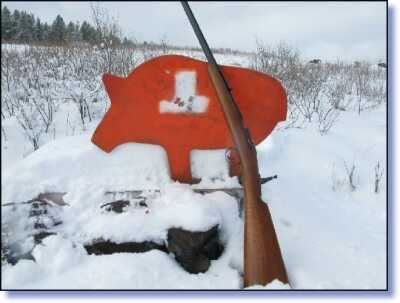 |
| The results of a good day with the Lyman-sighted .22 sight, offhand at 170 yards. |
 |
The diameter of the hole used needs to be larger as the sight becomes further from your eye. Generally, the sight should be quite close to the eye, but recoil and the mounting requirements of different rifles often dictate the distance. Said another way, a peep sight can work perfectly from distances almost touching your eye, all the way to the front receiver ring on a bolt rifle, if the aperture size increases with the distance from your eye. Also, while a smallish hole may work well in bright sunlight and in an open field, it may reduce the light that reaches your eye and therefore the visibility of the front sight and target too much in lower light conditions. The dimension 1/8th inch is .125 thousandths. An aperture, used for general conditions should be at least half that large, with apertures of .090 or even the full 1/8th inch being common and very accurate. Merit makes a wonderful addition to most aperture sights. This is the Merit sight disk that has an iris diaphragm in it not unlike that in a camera. This allows you to adjust the size of the hole in the sight from large to small to suit light conditions or our individual preference.
The front sight used with an aperture matters. Again I think you should avoid the complication and clutter of the “target” style front sights on a hunting rifle. The hooded, globe or other than a plain post or bead actually works against the full usefulness of the aperture sights. I prefer a flat topped post, but a bead is excellent as well.
The sights themselves come in an amazing variety of shapes, styles and sizes. For our purposes we will concentrate on “hunting” sights, rather than target ones. There is certainly some cross-over, as many use what I would classify as target aperture rear sights on sporting-target arms like Sharps rifles. But I have found while guiding several elk hunters with these sights that they prove to be a rather severe handicap. Aperture sights, on sporting arms, have been around for a long time. I have seen European flint lock and even wheel lock rifles with aperture sights, and they exist on vintage crossbows and stone bows.
In the glory days of shooting; revolving around 1900, aperture sights came in a dazzling array, made to fit virtually any rifle imaginable from the single shots to lever actions, bolts, and even “express” double rifles. While the selection today is not quite that perfect there is a fine resurgence in both interest and availability. You can, within reason, buy an aperture sight to fit almost any rifle and do so without extreme expense.
The classic tang sights from the past have been recreated by their original makers. Both the Lyman and Marbles tang sights are available. They, with some modern manufacturing literary-license are true to the originals in form and function.
 |
| This little English double rifle is a .360 express, very similar to a .38-55. Its folding tang sight has served very well! |
Both can be folded down against the rifle’s grip when not in use. The Marbles sights are adjustable for windage and elevation, while the Lyman sights only move up and down. (Windage adjustment for sighting-in is accomplished by moving the front sight left or right.) Today the tang sights are essentially available for “classic” rifles and their modern reproductions, mainly lever actions and some single shots. In general, both original and reproduction rifles come with the necessary holes for mounting the tang sights. With some gunsmith or machinist alteration the sights can often be adapted to many other rifles.
In addition to tang sights, “receiver” sights were popular then and now. These as their name implies attach to the receiver, instead of behind it on the tang. These fit another wide variety of rifles, including many bolt actions. Lyman recreates their model 57 and 66 receiver sights that fit many lever actions, some modern bolt actions and muzzle loaders. The famous Williams “Guide” and “Foolproof” receiver peep sights are also available. They are currently made to fit a broad range of arms from Ruger 10-22s, many shotgun receivers, Remington 700s, Model 70s and all the way to classic Krags, Enfields and Springfields.
Beyond the classic sights, I have “peep” sights from two modern makers that are different than the norm. First there is the Talley peep sight, which fits onto a special modified base for their scope mounts. Like all other Talley products, these sights are wonderfully designed, almost invincible strong and precise. The Brockman Rifles sights begin with this theme and go a few steps beyond.
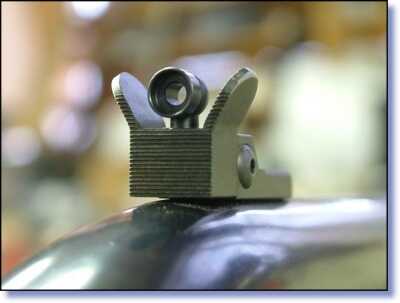 |
| Brockman Rifles adjustable aperture rear sight. |
They have a “Generation III” ghost ring sight that fits Marlins and many others. This has wings on the sides, like a military front sight, to protect the sight and is adjustable for windage and elevation. Their next level of sight is designed to be an instant companion to a scope sighted rifle. The Brockman “Pop Up” peep is designed to work in conjunction with a Talley scope mounting system, but this sight becomes a permanent part of the base. It is adjustable for windage and elevation and is spring loaded. When you put the scope on the base the tube pushes the aperture down out of the way. When you take the scope off, the peep pops up into the zeroed and ready to hit position. These form the perfect, instant, backup for a broken scope, or are ready to go to work any time you do not want to use your rifle with the optical sight. They are available for Marlin lever actions and Winchester Model 70s on a “ready made” basis, and can be custom made for most other bolt action rifles. In addition to the rear aperture sight, Brockman has a very special and innovative front sight system designed specifically to use with aperture rear sights.
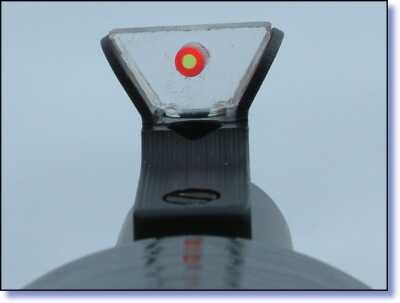 |
| Brockman Rifles “floating dot” front sight |
This is a really new, very old sight idea and I, for better or worse am responsible for it. One day, while having the grand privilege and delight to have free run of one of the finest arms collections on Earth, I discovered a sight. This was on a pretty little cased English rook rifle that was fitted with an original Lyman tang sight and that had a big, odd steel disk on top of the barrel just behind the normal front sight. When I rotated the cover away from the canister it uncovered a glass disk. The disk folded up into vertical position and revealed a red dot in its center. Yes, there is nothing new in the world, for this floating red dot was made in the 1880s. Before me was a red dot sight that floated in the open air, and offered one of the most amazing sight pictures I have ever encountered, when used in conjunction with the large Lyman aperture. This concept spawned the “new” Brockman front sight, that is essentially a floating colored dot; but now in a much more rugged and simple setting than the original British rook sight.
If we look back at the original catalogs from a century ago, we find them filled with testimonials for the “new” sights. It is interesting to note that many of the letters to Mr. Lyman began by saying that the new owners did not believe in, or like the new-fangled sights . . . until they tried them. Just like many of us today, the concept seemed too good to be true, but the doubt is replaced with words about record target scores, running bucks that folded or birds that were taken out of the sky. Today, most of us have to learn again what shooters used to know. The concept of peep sights is new to many shooters today, and in most ways seems too good to be true. My shooting evolved with a combination or conventionally sighted handguns and the most sophisticated scoped rifles, with little ground in between. I really did not fully comprehend the wonder of aperture sights until I fitted a tang sight to a humble little single shot .22 rifle. Its front sight is a ..060” wide blade. The rifle was a familiar friend and it shot very well with its original sight on the barrel, but that sight was getting fuzzy. One day I used electrical tape to temporarily mount a Lyman sight for a model 94 Winchester on the little friend. Zap,
 |
| A receiver sight on a model 94 saddle gun that I carry against poachers. This is a reliable combination in the gravest situations. |
the aperture brought its original sights and targets at any distance into perfect focus. That was fun and interesting, but I remembered the instructions from the past, “take the barrel sight off the rifle.” Instead of removing the sight, I simply lowered it to its “20-yard” setting and adjusted the tang sight to a 100 yard zero. The top of the front sight was now far above the barrel sight and did not interfere with the sight picture with the “peep.” I had a big aperture hole, which made the sighting appear random, but low and behold, hitting 2-inch objects at 100 yards was easy. Then I tried a longer shot at a target over 150 yards away. It was a 12-inch square steel plate that would ring with monotony when I fired at it offhand! Okay, off to the milling machine to modify the base and make new holes. A few hours later the sight was a permanent part of the little rifle. (I also almost immediately fitted a Marbles to a larger target version rifle.) Benchrest groups, at 100 yards and more, are kind of spooky; the kind of groups I would expect with a good scope. All other magic aside, part of the precision of an aperture can be explained by the long sight radius it creates. Essentially, greater distance between front and rear sights increases the potential accuracy of the system. A tang sight usually increases the sight radius by 50% or more beyond the barrel sight. Along with precision came speed. A bouncing golf ball is in much danger at 20 yards also.
A peep sight is a very special thing that is the fastest and most effective non-optical sighting system available. If you are a dedicated iron sight user and have not tried a “peep,” you are missing something wonderful. Or, if you think you have to have a scope to hit well; I guess it is a little like betting against the guy in bib overalls, shooting a worn out Model 12 at a turkey shoot. Better keep your money in your pocket!
Sources:
https://www.talleymanufacturing.com
https://www.brockmansrifles.com
https://www.BuffaloArms.com
https://www.MidwayUSA.com
https://www.Cabelas.com

I have a vintage redfield peep (similar to the one pictured above) on my 1943 Winchester 94. It’s shooting high, about 3″ high of the target, at 25 yards.
Can anyone give me instructions on how to adjust the sight so I’m not hitting hit, but close to right on?
Thank you.
Great article. I am a new shooter. Would shooting with open sights be counter-productive for shooting with aperture sights, then? So I should avoid rifles that come with open sights… at least at first, maybe, until I get used to aperture sights?
Although, of course, if I’m going to shoot pistols, they almost never seem to have aperture sights. And it doesn’t really seem to make sense for them to…
Help!!!
I am now just over 50 years old & I have worn glasses for 40 years. I shoot competively at local Sass club and have won top gun for my class twice but I am having a real problem shooting my 45-70 lever action at 100yds. I switched to a peep sight this year but the problem I am having now is an annoying shadow that creeps up from the bottom of the peep circle which makes it hard to even see my target! What can I do to eliminate this problem? Should I use a bigger peep or smaller peep, or is it unfixable because of my eye’s? I should mention I just had catarac surgery on my left eye but my right eye is not bad enough to qualify for surgery. I also shoot right handed and I am right eye dominant.
Thanks for any help you can give! Bruce
degenerative eye conditions are something we’ll all have to deal with. Best advice? Change class. But if you want to experiment with peeps just use paper and a needle kit from a fabric store and see if any of them help.
The shadow that creeps up from the bottom is caused by your upper eyelid. Seriously, your upper eyelid.
You are right!
I was a Marine in the 1960s and learned to shoot in boot camp. I was fortunate enough to go through when the M14 was the standard issue weapon and learned to appreciate the aperture sights used on the M1 and M14. I don’t shoot anymore but I was feeling nostalgic and ran across this article. I have used both optical and iron sights for match competition and hunting over the years but I have always enjoyed the feel and satisfaction of hitting a target using iron. An excellent article.
I have been shooting for more then 60 years and I never held my front sight so high as it is in the top two pictures.The front sight should be down so that the small tip is in the gruve in the back sight.Im I right or wrong?
No you are wrong. That is true if you were USING the back component of the standard “open sight” system. What you don’t see in the top picture is the “peep” site…the picture is simply showing you what you see when you look THROUGH the “peep”. Most people would just remove the notched rear site and throw it in a drawer to never find again. You look through the peep, without any focus or concentration on it at all, and put the bead or top of the post on the target. Your eye naturally CENTERS the bead or top of post at the strongest point of light (which is the exact center of the hole or “peep”), so all you have to do is look through it and put your front sight on the target. Anyone who has not shot or hunted with a receiver/peep sight is really missing out and carrying much more weight than they have to (about 2 pounds-worth of scope weight). They are wonderful!
I’ve never had a rifle with a peep sight and every one I pickup with one makes me think there must be some kind of voodoo involved. This article didn’t answer all my questions about how to use them or how it actually works, but it was a good start and makes me really want to pickup the M1A sitting at the gun shop to test out my knew found knowledge!
Many people have a hard time with a peep sight because they are trying to use it like a conventional open site, i.e. they are trying to first acquire the rear sight, then put the front sight into it, then acquire the target. With a peep, this is entirely WRONG. You just FORGET the peep and look through it. You don’t try to “line it up” or “center it” or anything…you simply look through it and focus on the front bead. Your eye will automatically find the exact center of the peep with no effort on your part, because the center will be the point of most light. Your eye will do that every single time you look through it and, the same exact spot in combination with the sight radius, will lend itself to outstanding accuracy. Every rifle I have which has a peep sight on it shoots just as well as it does with a scope mounted, while being much easier to carry, and just more fun to hunt and shoot with.
Goyard is a French manufacturing company that was established in 1853, a year before the louis vuitton sac Company that the famous LV monogram
was designed. 8 billion, up 2 per cent from the previous
year. The green hologram at the heel and forefoot for cushioning,
and the site says they feature Warren Buffett on
all Kings. Looking for Live OSCARS coverage?
Ross, I just found your new articles. I was looking for your old articles on the 500 Linebaugh, since I just made a deal to buy one of Linebaugh’s early conversions, one with a single digit production number. It’s a gun that I will be shooting. Your writing originally inspired me to search out and own a 500 Linebaugh, and years later, today in fact, this 510 Linebaugh made in 1986, so I’m glad to see this new material. Thanks!
Great-reading article, entertaining and informative. I, too have ‘rediscovered’ peep/tang sights, having started with them in Junior Rifle Club on a cut-down Winchester Model 67 single-shot suitable as a target rifle for a 9-yr-old. If anyone doubts that accurate shooting is possible…somewhere we still have the Camp Perry score postings for the 1967 Wimbledon Cup Match, in which Dad fired a 97-6X…with a NM M-14 Service Rifle (Kansas National Guard Rifle Team). For a time Taurus made a windage and elevation adjustable tang sight for their copies of Winchester .22’s, and they work admirably on the originals. I have several, at $38/ea. They were available until a few years ago from Taurus USA. (They also work on Lo-wall Winchesters). NECG also makes a peep sight that mounts on Weaver-type bases that’s quite repeatable once set up.
I’m glad I found this article, it has helped me immensley. I’m 65 years old and my eye sight isn’t what it used to be. Always shooting with open sights, I found myself missing a lot of my shots. I purchased an AR-15 with the peep sight and always thought the front sight had to be centered in the middle of the hole on the peep. Since reading this and only concentrating on the placement of the front sight on the target, I’ve been able to hit what I was aiming at almost all of the time. Thanks for helping me to become a better shooter!
Great to have you writing again Ross! I’ve enjoyed and learned from your articles for years.
I was fortunate, my Mother taught me about the advantages of peep sights when I was a kid. Put my first peep on my Benjamin pellet rifle at age 12. I like shooting with irons,and I particularly like the looks and balance of a rifle without the bulk and weight of a scope.
very good article , i am using lyman #57s on my mausers (various mods) and my win pre64 mod 94 in 30-30 has a great redfield on it ,i also have a redfield #70 but can’t decide which rifle will get lucky .
my enfield #1 mk111 has a handsome rawson target aperture sight on it .
needless to say my old eyes really like “peeps” .
as writen just ignore the ring and consentrate on the front post///bead whatever you have equipped and it will all come together,,,,,, trust me ,i kid you not ..
My project in recent years (with much effort this spring) is in adding aperture sights to a number of my guns – 1/3 of my collection and counting. Honorable mentions, in my experience: XS, Skinner low-profile, Marbles, Ruger One hole (handguns!)
BTW maybe just a coincidence but I’m turning 41 this year. 😛
Thank you Ross for summing up what knowledgeable shooters have known and relied on for YEARS! Your articulate and engaging style of writing explains the peep / aperture sight concept perfectly. I make www skinnersights com and it seems the shooting public has re-discovered this MAGICAL sight!
I was so pleased to stumble upon new articles written by Ross Seyfried, one of my very favorite gunwriters. I have enjoyed Mr. Seyfried’s work for decades now. I have always found his writing enjoyable, and more importantly, instructive. I have missed seeing his work in print for some time now, and am so glad to have found him as a contributor at Guns America. Almost like running into a long lost and missed old friend. Keep up the good work, Ross!
Thanks for the great article on aperture sights. I have several aperture sights fitted to rifles I own, either as primary sights, or backups to optical sights. Most of mine are made by XS Sights Systems, with a Williams FP and an old Redfield thrown in for good measure, as well as a detachable carry handle sight on a flattop AR.